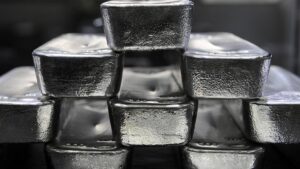Monsters of Rock: Rio quiet on whether it wants to join BHP’s copper race for Anglo American

Could Rio Tinto emerge as a rival in BHP's Anglo American game? Pic: Getty Images
- Rio Tinto leaves investors guessing on M&A thoughts in mild Brisbane AGM
- Northern Star adds to resources and reserves in ho-hum exploration update
- Meteoric rises on rare earths supply MoU
Rio Tinto (ASX:RIO) chairman Dominic Barton has declined to respond to a question at the miner’s Australian AGM in Brisbane on its JV interests and intentions re: BHP’s rejected $60 billion bid for Anglo American.
Giving the standard no comment to M&A talk from activist investor Stephen Mayne, the Canadian ex-diplomat and consulting veteran declined to be drawn into discussions about its biggest rival’s copper-hungry approach for the historic London-listed miner.
It wasn’t the only thorny topic, many raised by the inquisitive Mayne, with CEO Jakob Stausholm again outlining why Rio won’t fork out cash to buy out minorities it thinks should stump up equally to remediate Energy Resources of Australia’s (ASX:ERA) white elephant Ranger uranium mine.
There was also the standard call and response on a slew of environmental issues where NGOs and Rio are worlds apart in their interpretation of the situation, notably alleged pollution at its mineral sands operations in Madagascar.
Rio has also faced the prospect of a major share sale by 2.7% holder Norges Bank over reports a new bauxite mine in the Amazon developed by MRN, a company partly owned by Glencore, South32 (ASX:S32), Rio and a Brazilian aluminium company, had not consulted affected traditional riverine communities.
However, outgoing director Simon McKeon did say in an exit speech, which criticised Rio’s role in the Juukan Gorge disaster in 2020 as well as its failure to take responsibility for the failings in the months after, that the company had transformed culturally and turned a corner when it came to its social responsibilities.
“Of course, we cannot realise the full potential of these assets without a strong social licence. Our understanding of this is deepening across our teams,” CEO Stausholm also said in his address.
“How we are progressing with social licence is difficult to say, as it is not judged by us, but society at large.
“However, as I engage with stakeholders, my overwhelming feeling is that we are more and more finding mutual ground.
“We are embedding our approach to co-management and co-development throughout the business, while continuing to work closely with Traditional Owners to ensure better outcomes for everyone.”
Rio’s resolutions passed comfortably, outside of a vote to approve a share buyback which received a large protest vote from top shareholder Chinalco. Chinalco doesn’t want to sell shares into the buyback, which has seen its shares move perilously close to a 14.99% ownership limit placed by the Australian Government.
Northern Star delivers bland R&R upgrade
In need of a little rest and relaxation? Look no further thanNorthern Star Resources (ASX:NST) annual resource and reserve upgrade, which has a similar vibe to whale songs.
Reserves and resources crept up 4% and 7% on the year to 61.3Moz and 20.9Moz, with 60Moz of resources at producing sites.
That includes a maiden underground reserve at the Super Pit in Kalgoorlie of 800,000oz, with mineral resources up 400,000oz to 5.5Moz.
The resource at the six decade young Mt Charlotte mine was also up 500,000oz to 4.1Moz, with a maiden ore reserve at the 1.9Moz resource Red Hill deposit near Kanowna Belle of 600,000oz.
There were impressive drill hits also at the Hercules discovery 35km from KCGM including 16m at 18.7g/t, 19m at 12.9g/t anf 35m at 6.5g/t.
The Griffin zone at the Jundee underground mine has also demonstrated its potential, with narrow hits of 0.3m at 322.5g/t and 0.6m at 107g/t.
To some extent, though, resource and reserve upgrades reflect higher gold price assumptions.
The price used to calculate mineral resources at Kalgoorlie and Yandal have risen from $2350/oz to $2500/oz, with Pogo in Alaska lifting from US$1600/oz to US$1800/oz.
On reserves, NST has lifted its Australian price assumption from $1850/oz to $2000/oz, while Pogo’s reserves have been calculated at US$1500/oz, up from US$1400/oz. NST has guided a spend of around $150m on exploration for FY24.
The strongest growth was seen at KCGM, where resources grew 12% to 31.6Moz.
“The 3.9Moz increase in Group Mineral Resources is even more impressive when considering the significant mining depletion that has occurred over the past year as we ramp up production in line with our profitable organic growth strategy,” NST MD Stuart Tonkin said.
“KCGM continues to impress, with an outstanding 3.3Moz added to the mineral resources and 1.0Moz to ore reserves.
“These additional high-margin ounces are close to existing mine infrastructure and further strengthen the economics of our strategy to boost production to a sustainable 900kozpa from FY29.
“Our exploration program remains a highly attractive approach to value creation, adding extra ounces at a cost of just A$31/oz, to support our purpose to deliver superior shareholder returns.”
RBC’s Alex Barkley, who has an outperform rating and $15 price target on Northern Star, said the update was mixed, with reserve grades down 8% and resource grades off 10%.
“The increase in gold was aided by a modest increase in R&R calculation prices. This increase in material could have contributed to the reduced grade,” Barkley said in a note.
“Pogo Reserve grade declined to 8.0g/t (from 8.6g/t). NST had previously suggested this was possible; we had also expected a reduction was likely in recent notes (RBCe FY25 7.9g/t).
“The biggest gold increases were at KCGM and Kalgoorlie Ops, with some reductions elsewhere. No sites have imminent short-life issues, and NST should have ample time to progress its pipeline of discoveries.
“We consider NST to have strong capability to generate new R&R gold. This is demonstrated by another annual increase in gold, even net of depletion.”
NST shares rose 2.32% to $14.77 as of 1.45pm AEST, while the LBMA reported closing gold prices yesterday of US$2302/oz, around $3523/oz Aussie.
Gold producers were buoyed by commentary out of the US Fed, where chair Jerome Powell said rate hikes were unlikely after the board of governors left rates unchanged at 5.25-5.50% at their May sojourn.
According to the CME’s Fedwatch Tool the market is pricing only a 9% chance of a rate cut in June, with September the first meeting when the chance of a rate cut is a higher probability than a pause.
Market movers
The ASX materials sector, which contains the big miners, was up a handy 0.55% at 3.15pm AEST.
Beneath the ASX 200, Brazilian rare earths hopeful Meteoric Resources (ASX:MEI) was among the top performers, lifting 7% after announcing a non-binding MoU to supply Canadian based Neo Performance Materials 3000t of total rare earth oxides a year.
The material would be key inputs for Neo’s Sillamae rare earth separation facility in Estonia and a proposed magnet manufacturing plant in nearby Narva.
Meteoric aims to be in production at Caldeira, one of the world’s largest and highest grade clay rare earths discoveries, in the second half of 2027.
“We are very pleased to be bringing this important agreement with Neo to market,” CEO Nick Holthouse said.
“This represents Meteoric’s first step in our staged offtake strategy, and are delighted to support Neo in their aim to provide high-performance magnetics for automotive, factory automation, high-efficiency motors, residential appliances, and many other industries.
“Connecting and integrating into the developing alternate rare earth materials supply chain signals strong external market confidence in the Caldeira Project`s ability to progress to an FID and into production. We look forward to working with NEO and having the benefit of their technical support as we continue to pursue and develop our own downstream capabilities and progress to a binding commercial arrangement.”
Today’s Best Miners
Meteoric Resources (ASX:MEI) (rare earths) +7%
West African Resources (ASX:WAF) (gold) +5.3%
Coronado Global Resources (ASX:CRN) (coal) +4%
Energy Resources of Australia (ASX:ERA) (uranium) +3.9%
Today’s Worst Miners
WA1 Resources (ASX:WA1) (niobium, rare earths) -3.9%
Core Lithium (ASX:CXO) (lithium) -3.5%
Wildcat Resources (ASX:WC8) (lithium) -3%
Alumina (ASX:AWC) (alumina) -2%
Monstars share prices today
ASX 300 Metals and Minings Index today
Related Topics

UNLOCK INSIGHTS
Discover the untold stories of emerging ASX stocks.
Daily news and expert analysis, it's free to subscribe.
By proceeding, you confirm you understand that we handle personal information in accordance with our Privacy Policy.








